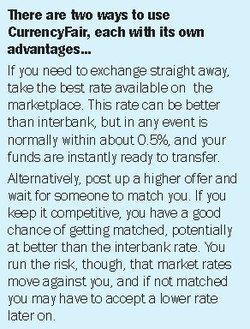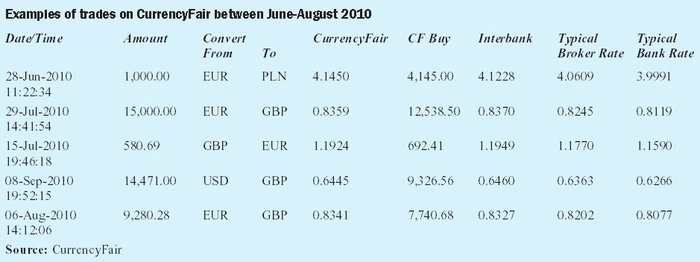Dublin based start up Currency Fair became fully functioning on May 7th 2010 after a five year process from the inception of the original idea to its launch this year. The idea came to co-founder Brett Meyers five years ago when he imagined a peer to peer online currency exchange marketplace - disintermediating banks and brokers and slashing costs for users.
Meyers, an Australian, was working in the IFSC when he dreamt up this online currency marketplace. The idea he says was inspired from his own personal experiences transferring money back to Australia. What he envisaged was a marketplace where individuals could exchange currency with each other without banks or brokers in the middle of the exchange.
His idea of an online order driven market for currency would be a means to bypass both banks and forex brokers. Meyers thought that by allowing market forces of demand and supply amongst private individuals it would result in lowering costs for users compared with the costs of using forex brokers and banks - where an exchange can be 5 per cent worse than the interbank rates. And while this was just an idea five years ago, now Currency Fair is working in practice and for him some of the results are more fascinating than he could have imagined.
‘You can beat the interbank rate!’ he tells me when referring to a trade where one user found an offer on Currency Fair that was better than some banks were able to achieve on the interbank market. This iconic trade proves for Meyers what the site can achieve for users. The unique interbank trade is just one of many trades that have saved money for its customers and is an example of how Currency Fair users routinely trounce what many people can get at either the bank or with a forex broker.
‘The results are fascinating’ he says, ‘Our users are making exchanges that are 1 – 1.5 per cent lower than what they are being offered by their banks. This is done because customers can offer the rates they want and typically they will find a match sometimes exceeding their expectations. We have a great product.’
‘The first transaction on the site was made for €400,000 and it saved the client €5,000 on the quoted rate from their bank.’ he says. Banks and brokers are typically charging 3 per cent on currency transfers. They offer a commission based sales transfer at 3-3.5 per cent with transfer fees of €20 – 25 fees. Currency Fair does not charge a commission and the rates are typically 1 per cent and 1.5 per cent lower than the banks rates.’
The success of the market is reliant on the number of users and offers on the site. Meyers says they are meeting the numbers needed and they are on schedule to reach their year end target of 10,000 users. So far there has been four times more transmissions than they had forecasted.
The site trades in 12 currencies. Some currencies are more self sustaining then others. For instance, Euro Sterling is completely self sustaining. For currencies, which are less self sustaining, Currency Fair will always ensure that there are offers on the site by putting up offers themselves. It is actually through this trading that Currency Fair earns its primary revenue. Meyers says that the rates that Currency Fair offer are always lower than what users are likely to get through brokers. In addition to trading on the site, Currency Fair have plans for new revenue streams and products such as a pre-paid travel credit card. This will work with users crediting currency that is exchanged on Currency Fair to the card which would then be used like a credit card
While Currency Fair do have ‘some small businesses and some corporate accounts’, its primary users are private individuals says Meyers. The typical user is someone who is paying bills in a foreign currency on a regular basis, e.g. mortgage repayments.
In light of its target market, Meyers sees the ex-pats as the primary target market for Currency Fair . The firm has so far focused a lot of its PR in the UK as the company is particularly interested in gaining traction in the UK ex-pat market.
The marketing and design of CurrencyFair.com is different to traditional financial services websites. The main aim behind the look and feel of the site has been to focus on the ‘people’ and users of the site. Upon visiting the site this is immediately apparent. On the homepage there are profiles and testimonies of some of its users. This decision to focus on the people or community element of the site was a decision to distinguish themselves from the more conservative traditional financial services website design.
While this decision is made to give potential users a sense of trust with brand, they must go further to ensure users feel comfortable and secure. So in addition to the light hearted approach to the website design, the site is also eager to highlight in very clear terms the security measures taken by Currency Fair to protect its users and to make it clear that they are regulated by the Irish Financial Regulator.
Security on the site is significant. All users are required to register with Currency Fair before they can exchange on the site. Once they have an account any funds they want to transfer are held in an account with the Bank of America. The client funds are held in separate accounts. ‘If we go bust client money is not accessible it is always owned by the client.’ There is fixed segregation of the clients accounts. Meyers also points out that they have taken major steps on data protection too and that they use a state of the art data centre in Dublin.
The process of bringing Currency Fair to market has been a learning process for Meyers and the other four executive directors, however this process has been all the more easy due to the fact that the team behind it bring considerable skills from a variety of sectors and backgrounds. The four behind Currency Fair are: David Christian, Jonathan Potter, Sean Barrett and Meyers. Meyers himself is a product of the IFSC and cut his cloth working with JP Morgan in structured finance as head of analytics in what ‘he describes as a business oriented IT team.’ His background in both IT and in finance which would seem the perfect mix to set up Currency Fair.
Meyers and one of his partners left ‘good jobs’ to begin the full time commitment to the business in July 2009. Along the way there were difficulties such as the long but very necessary regulatory process which ran from November 2009 to April 2010. Despite this he is very eager to praise the advantages of Ireland’s business environment. When I asked Meyer why he choose to set up in Dublin, he says that ‘Dublin has the right attitude’ and he mentions the low corporation tax environment as an attraction. They are also very grateful for the help they got from Enterprise Ireland and the willingness of Minister of Trade and Commerce Billy Kelleher to launch the company in Australia which he sees as being a great boost.
Meyers is also is very excited by the ‘e-money movement’ in Dublin led by a number of key figures namely Eoin Jennings and David Lowe. He says there is a real push to make Dublin an e-payments hub and there is every reason to believe it can become a reality. There is a big movement to replace credit cards and it is a real opportunity for Dublin, he says.


